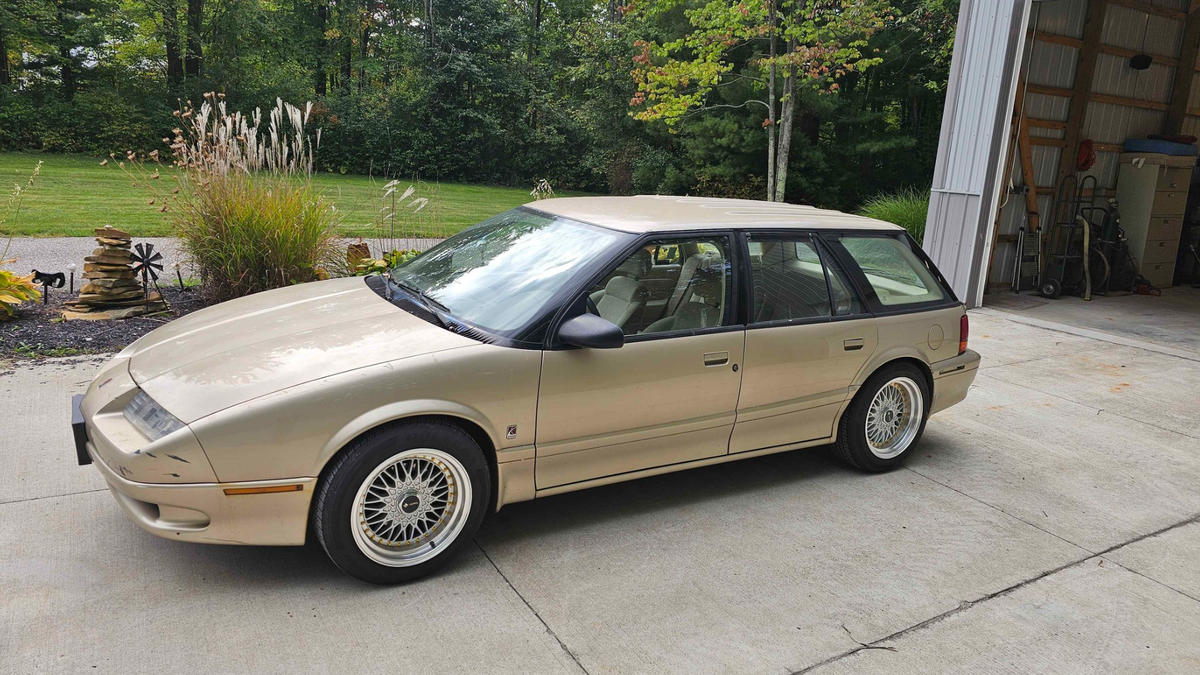In This Story
I’m normally not one to throw automakers a good ideas for free. I’m much more on the mocking bad ideas side of things, but this idea is so choice I’m going to break with tradition. General Motors, GM, The General, Bubbeleh, babe—to save your pivot to EVs in a time of slowing sales, you must bring back one of the best ideas your company ever produced: It’s time to bring back Saturn as an EV brand. Not just an EV brand, a brand geared towards introducing skeptical buyers to the EV.
I know I’m not the first to think of this, because it’s an obvious move to a lot of folks in the biz. However it was the beautiful first-gen 1995 Saturn S-Series wagon pictured up top that motivated me to express the idea in post form. On sale in my area for the very acceptable price of $3,500, I am at war with myself over buying it. I owned a Saturn Ion in the same gold color and, while that car was neither quick nor impressive, it was a good car that lasted and worked (I mean, besides the deadly ignition switch, but we can forgive and forget can’t we?) right up until it didn’t. A fuel pump killed my Ion, but it made it 185,000 miles without complaint before it’s death. With a little love, this Saturn S-Series would be a Radwood hero.
So why would Saturn, a company murdered in 2009, be the perfect EV brand? Let’s take a look:
Saturn was known for building affordable, efficient cars—something of a rarity when it comes to the EV market these days. GM produces many giant, expensive, electron-sucking 9,000-pound EVs for the U.S. Besides Chevy Bolt, it doesn’t really have anything on the affordable side for electric vehicles and, with an MSRP of around $45,000, you can’t really call the Bolt super affordable.
GM initially wanted customers to forget Saturn was an American brand, but it also built Saturns right here in America, giving its products a little extra patriotic flare. A cheap, cute, American-made EV with built-in brand loyalty would be the perfect introductory EV. It might even draw folks who wouldn’t really consider going electric into EV ownership thanks to the lower price (and lower stakes.) This might even motivate the buying public to transition into those bigger, more expensive EVs in the future from the trusted brand that taught them to stop worrying and love the electron.
The most successful EV company in the U.S., Tesla, has a bad reputation for customer service. Saturn, however, was a brand that was obsessively focused on creating a positive customer experience. When I worked in customer retention for a creative agency hired by GM in 2011 the big wigs would still have huge meetings with the head of the four surviving brands about what they could do to keep Saturn costumers. That kind of focus on the ownership experience is exactly what new EV owners need. You did it once, GM, you can do it again.
Finally, I mean, come on, the tagline for this new-old company writes itself if GM kicks off with the Ion. For you see kids, an ion is a any atom or group of atoms that hold a charge, positive or negative. In this case however, you’re going to focus on the positive, because “The All-New Saturn Ion EV: Positively Charged” is just too good. There’s such a focus on aggressive styling and high powered huge vehicles that there is a huge gap in the market for something fun and affordable. Offer cool colors like the Geo line up and you’ve got an EV brand perfect for a younger, more urban set.
I know profits on EVs are either razor thin or non existent at this point, and building small cars that are also EVs seems like a great way to build a giant money fire in front of the Renaissance Center, but we’re thinking long game here. An accessible baby’s-first EV is about building a base with customers that will grow sales over time. This idea is for you to run with, GM. You don’t even need to pay me for it. I only ask that it starts with a wagon option as sick as those first-gen S-Series.

